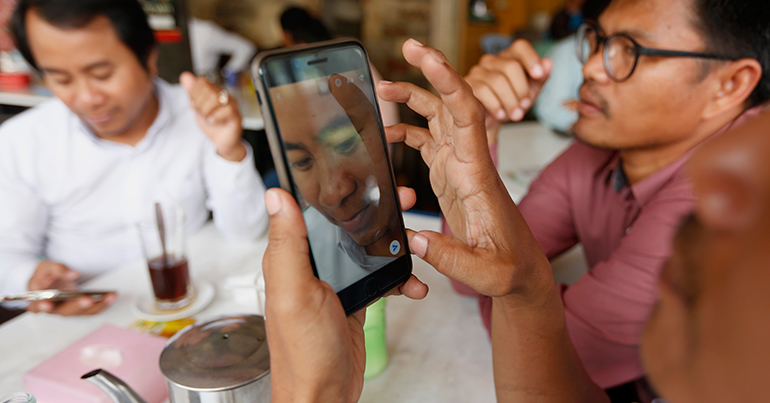A digital wave is sweeping across Southeast Asia. As traditional forms of communication, shopping and payment are pushed aside in favour of new technologies, the region’s young people are finding more and more opportunities for prosperity

Driven by a young and tech-savvy population, Southeast Asia is quickly becoming the world’s fastest growing internet market, with millions of new users coming online every month.
According to a recent Digital 2019 report, released by social media management platform Hootsuite and global media agency WeAreSocial, Southeast Asia topped the charts in growth of unique internet, mobile and social media users over the course of 2018.
With a population of over 659 million and a collective gross domestic product of $2.5 trillion, Southeast Asia is on track to become the world’s fifth largest economy by 2020. The digital economy reached over $30 billion in 2015, and is expected to soar in upcoming years to reach nearly $200 billion by 2025.
These estimates for growth are dependent on ever-increasing numbers of internet, mobile and social media users in the region, as Southeast Asia’s digital economy is fuelled by increased activity on the world wide web.
Going mobile
In a region where mobile data is cheap and smartphone penetration is ever-growing, it’s no wonder that Asia Pacific is the leading region when it comes to mobile data traffic. Last year, data use grew by 29% to reach nearly 19.5 billion gigabytes’ worth of data per month – far ahead of the second-most data-thirsty region of western, central and eastern Europe, where fewer than five billion gigabytes are consumed monthly.
While Northeast Asia is leading the charge in monthly data use, Southeast Asia is a growing market for mobile data, with overall internet penetration across the region standing at about 63% and mobile penetration steadily rising across the region. At 129% mobile penetration, Southeast Asia is the foremost leader across the Asia-Pacific, ranking fourth globally behind only Eastern and Southern Europe and Southern Africa.
The majority of Southeast Asia’s nations – including Vietnam, Singapore, Thailand, Indonesia, Malaysia and the Philippines – are all above the worldwide average of 115% for mobile penetration, and Myanmar is showing signs of significant growth as well, welcoming nearly 4 million new connections to rank thirteenth globally for year-on-year growth.
Southeast Asia is home to several leaders in mobile connectivity as well, a category that accounts for several enabling factors – like infrastructure and affordability – as well as connectivity indicators and mobile network dimensions. Singapore, Thailand, Malaysia, the Philippines, Vietnam and Indonesia rank among the top 40 countries in the world for the overall mobile connectivity, according to a recent assessment.
But considering Southeast Asia still struggles with a hefty unbanked population, mobile connections – common as they have become – are typically prepaid in several countries across the region, including Indonesia, the Philippines, Vietnam and Thailand. Timor-Leste ranked among the top ten countries globally where mobile connections are pre-paid, and none of Southeast Asia’s countries were among the top ten countries where mobile connections are paid for after use.
Making friends
Social media usage has been on the rise across the entire region as well, with more users coming online and immediately opening Facebook accounts than ever before. Across the region, social media penetration reached 61% and mobile social media penetration reached 56% over the course of the past year, making Southeast Asia the second-most active region in Asia Pacific for social media use behind only Eastern Asia.
Indonesia, the Philippines and Vietnam saw the most year-on-year growth in mobile social media usage in the region, ranking third, fourth and fifth – respectively – for most rapid growth across the globe. In a single year, Indonesia welcomed 10 million new users, reflecting an 8% increase; the Philippines also welcomed 10 million new users for a 16% increase; and Vietnam saw 8 million new users for a 16% increase.
When it comes to social messaging platforms, Southeast Asia is pretty heavily dominated by Western-owned and operated WhatsApp and Facebook messenger, but some smaller, more local platforms are vying for attention too: Zalo, Vietnam’s very own flagship messenger app, has come to dominate the Vietnamese market, while Thailand is using the Japanese brand Line more than any other platform.
Banking on change
Unsurprisingly, Southeast Asia’s most digitally advanced countries have also proved to be among the most economically sound: Singapore topped the charts as having the highest gross domestic product (GDP) per capita among all countries worldwide, and both Malaysia and Thailand ranked above the worldwide average.
These are also the same countries that rank in the top ten countries worldwide in terms of mobile banking penetration, with Thailand first among the world’s nations for access to mobile banking services, Malaysia ranking sixth and Singapore ranking seventh. Indonesia, the Philippines and Vietnam also placed above the worldwide average. All of these countries barring Singapore and Indonesia also rank above the worldwide average for use of mobile wallets.
[manual_related_posts]
The rest of the region – Myanmar, Cambodia, Laos, Timor-Leste and Brunei – ranked well below the worldwide mobile banking average of 41%, and also rank below the 37% average global usage of mobile wallets. These countries also have the lowest overall GDP among the Southeast Asian nations.
But as Southeast Asia’s young population grows up with mobile devices in hand and internet access at their fingertips, literacy rates are rising, with 95% of the region’s men and 91% of the region’s women able to read and write; e-commerce is growing, Indonesia topping the global charts with the highest percentage of internet users buying goods online, followed closely by Thailand and Vietnam; and the region’s leading countries are paving the way forward, toward a more prosperous, technology-filled future.

